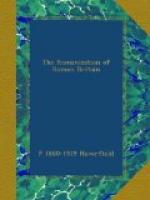[Footnote 1: It has been suggested that these mosaics were principally laid by itinerant Italians. The idea is, of course, due to modern analogies. It does not seem quite impossible, since the work is in a sense that of an artist, and the pay might have been high enough to attract stray decorators of good standing from the Continent. However, no evidence exists to prove this or even to make it probable. The mosaics of Roman Britain, with hardly an exception, are such as might easily be made in a province which was capable of exporting skilled workmen to Gaul (p. 57). They have also the appearance of imitative work copied from patterns rather than of designs sketched by artists. It is most natural to suppose that, like the Gaulish Samian ware—which is imitative in just the same fashion—they are local products.]
[Illustration: FIG. 11. RESTORATION OF PAINTED PATTERN ON WALL-PLASTER AT SILCHESTER. Showing a purely conventional style based on classical models. (P. 34.) (From Archaeologia.)]
Nor is the Roman fashion of house-fittings confined to the mansions of the wealthy. Hypocausts and painted stucco, copied, though crudely, from Roman originals, have been discovered in poor houses and in mean villages.[1] They formed part, even there, of the ordinary environment of life. They were not, as an eminent writer[2] calls them, ’a delicate exotic varnish.’ Indeed, I cannot recognize in our Romano-British remains the contrast alleged by this writer ’between an exotic culture of a higher order and a vernacular culture of a primitive kind’. There were in Britain splendid houses and poor ones. But a continuous gradation of all sorts of houses and all degrees of comfort connects them, and there is no discernible breach in the scale. Throughout, the dominant element is the Roman provincial fashion which is borrowed from Italy.
[Footnote 1: R.C. Hoare, Ancient Wilts, Roman Aera, p. 127: ’On some of the highest of our downs I have found stuccoed and painted walls, as well as hypocausts, introduced into the rude settlements of the Britons.’ This is fully borne out by General Pitt-Rivers’ discoveries near Rushmore, to be mentioned below. Similar rude hypocausts were opened some years ago in my presence at Eastbourne.]
[Footnote 2: Vinogradoff, Growth of the Manor, p. 39.]
We find Roman influence even in the most secluded villages of the upland region. At Din Lligwy, on the northeast coast of Anglesea, recent excavation (Fig. 12) has uncovered the ruins of a village enclosure about three-quarters of an acre in extent, containing round and square huts or rooms, with walls of roughly coursed masonry and roofs of tile. Scattered up and down in it lay hundreds of fragments of Samian and other Roman or Romano-British pottery and a far smaller quantity of ruder pieces, a few bits of Roman glass, some Roman coins of the period A.D. 250-350, various iron nails and hooks, querns, bones, and so




